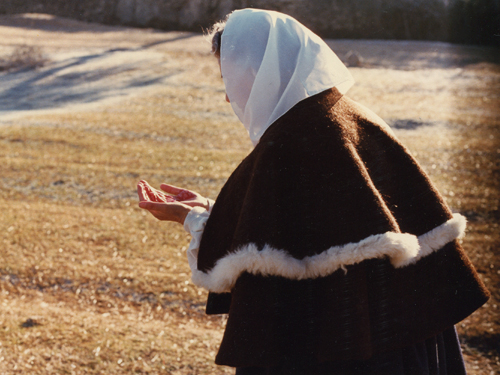
“Where are we in Ana? In Portugal, since the filmmakers are Portuguese. But this small country is still too big. In the North of Portugal, in the region of Miranda do Douro, where Reis and Cordeiro have already shot a film a few years ago, another wonderful and unclassifiable film called Trás-os-Montes. Here and nowhere else. Here and anywhere else. Because the strength of Ana, which discourages in advance all lazy classifications, is just that. It’s been a while since a film has reminded us so clearly that cinema is at the same time an art of the singular and the universal, that images float so much better if they dropped their anchor somewhere. Ana-fiction? Ana-documentary? This distinction is really too crude. Documented fiction? Not even. Fiction means putting oneself in the middle of the world to tell a story. Documentary means going to the end of the world not to have to tell. But there is fiction in documentation as there are insects in fossile rocks, and there is documentation in fiction for the good reason that the camera (it cannot help itself?) records what you put in front of it, wherever you put it. Ana-end of the world? Ana-midst of the world?”
Serge Daney1
“Waar bevinden we ons dan in Ana? In Portugal, aangezien de filmmakers Portugees zijn. Maar dat kleine land is nog te groot. In het noorden van Portugal, in de streek van Miranda do Douro, waar Reis en Cordeiro enkele jaren geleden al die andere prachtige en niet te klasseren film die Trás-os-Montes heet, hebben gefilmd. Daar en nergens anders. Daar en overal anders. Want de kracht van Ana, die van tevoren alle gemakzuchtige classificaties ontmoedigt, is precies dat. Het is lang geleden dat een film ons er met zo’n vanzelfsprekendheid aan heeft herinnerd dat cinema tegelijkertijd een kunst van het singuliere en van het universele is, dat beelden zoveel beter drijven wanneer zij hun anker ergens hebben uitgeworpen. Ana-fictie? Ana-documentaire? Dat onderscheid is werkelijk te grof. Gedocumenteerde fictie? Zelfs niet. Fictie, dat is zich te midden van de wereld plaatsen om een verhaal te vertellen. Documentaire, dat is naar het einde van de wereld gaan om niet te moeten vertellen. Maar er is fictie in het document zoals er insecten zijn in fossiele rotsen en er is documenteren in fictie wegens het simpele feit dat de camera (die er immers niets aan kan doen?) overal waar men haar plaatst hetgeen registreert wat men voor haar plaatst. Ana-einde van de wereld! Ana-midden van de wereld?”
Serge Daney2
« Où sommes-nous donc dans Ana ? Au Portugal, puisque les auteurs du film sont portugais. Mais ce petit pays est encore trop grand. Au nord du Portugal, dans la région de Miranda do Douro, où Reis et Cordeiro ont déjà tourné, il y a quelques années, cet autre film magnifique et inclassable qui a le nom Trás-os-Montes. Là et nulle part ailleurs. Là et partout ailleurs. Car la force d’Ana, ce qui décourage à l’avance toutes les classifications paresseuses, c’est justement cela. Cela fait longtemps qu’un film ne nous a pas rappelé avec une telle évidence que le cinéma est à la fois un art du singulier et de l’universel, que les images flottent d’autant mieux qu’elles ont jeté leur ancre quelque part. Ana-fiction ? Ana-documentaire ? Cette distinction est vraiment trop grossière. Fiction documentée ? Même pas. La fiction c’est se mettre au milieu du monde, pour raconter une histoire. Le documentaire, c’est aller au bout du monde pour ne pas avoir à raconter. Mais il y a de la fiction dans le document comme il y a des insectes dans les roches fossiles et il y a du document dans la fiction pour le bonne raison que la caméra (c’est plus fort ?) enregistre ce qu’on met devant partout ce qu’on met devant elle. Ana-bout du monde ! Ana-milieu du monde ? »
Serge Daney3

